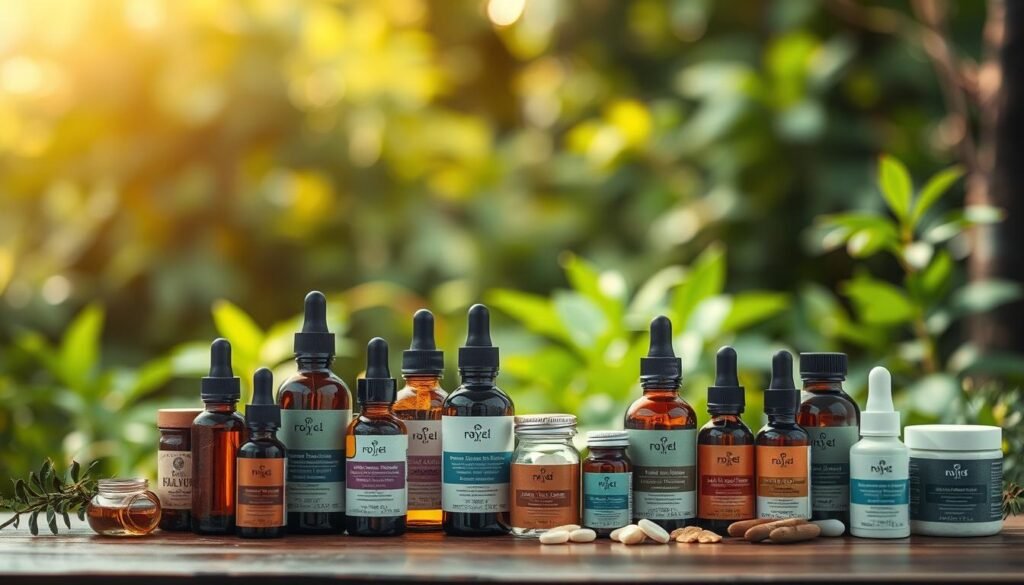Hair loss can be a distressing experience for many women, affecting their self-esteem and confidence. By age 50, approximately 40% of women experience some form of hair loss, making it a significant concern.
Understanding the causes and finding effective treatments is crucial. A healthy scalp is the foundation of healthy hair, and various factors, including genetics, hormonal changes, and lifestyle, can contribute to hair loss in women.
This comprehensive guide will explore the most effective hair loss treatments specifically formulated for women, including FDA-approved solutions like Minoxidil and alternative therapies.
Key Takeaways
- Understanding the underlying causes of hair loss is essential for selecting the most appropriate treatment.
- FDA-approved treatments like Minoxidil are effective for promoting hair growth.
- Alternative therapies, including light therapy and hormone treatments, can also be beneficial.
- A healthy lifestyle and proper hair care can help prevent further hair loss.
- Consulting a medical professional is crucial for determining the best course of treatment.
Understanding Female Hair Loss
Understanding the causes and symptoms of female hair loss is crucial for effective treatment. Hair loss in women can manifest differently than in men, and recognizing these differences is key to addressing the issue.
Common Types of Hair Loss in Women
Female hair loss can be categorized into several types, each with distinct characteristics. The most common type is androgenetic alopecia, also known as female pattern baldness, which affects up to 75% of women by age 65.
- Androgenetic alopecia typically presents as overall thinning and a widening part.
- Telogen effluvium is characterized by sudden, diffuse shedding often triggered by stress, pregnancy, or illness.
- Alopecia areata is an autoimmune condition causing patchy hair loss.
Signs and Symptoms to Watch For
Early signs of female hair loss include increased shedding, a widening part, visible scalp through the hair, and decreased ponytail thickness. Women may also notice their hair becoming thinner over time, with changes in hair texture and increased breakage.
| Type of Hair Loss | Characteristics | Common Triggers |
|---|---|---|
| Androgenetic Alopecia | Overall thinning, widening part | Genetics, hormonal changes |
| Telogen Effluvium | Sudden, diffuse shedding | Stress, pregnancy, illness |
| Alopecia Areata | Patchy hair loss | Autoimmune condition |
Understanding the specific type of hair loss is crucial for determining the most effective treatment approach. By recognizing the signs and symptoms, women can seek appropriate medical attention and explore available treatment options.
What Causes Hair Loss in Women?
Hair loss among women is a condition that can stem from a combination of genetic, hormonal, and lifestyle factors. Understanding these causes is crucial for identifying the most effective treatment.
Genetic Factors
Genetic predisposition is a significant cause of hair loss in women, particularly in cases of androgenetic alopecia. This condition is influenced by hereditary factors that determine sensitivity to androgens, which affect hair follicles. Women with a family history of hair loss are more likely to experience it.
Hormonal Imbalances
Hormonal fluctuations during significant life events such as pregnancy, postpartum, and menopause can trigger or exacerbate hair loss. Conditions like polycystic ovary syndrome (PCOS) and thyroid disorders also contribute to hormonal imbalances that can lead to hair loss. For more information on the causes of hair loss in women, visit WebMD.
Stress and Lifestyle Factors
Chronic stress, nutritional deficiencies, and certain hairstyling practices are among the lifestyle factors that can contribute to hair loss. Elevated cortisol levels due to stress can push hair follicles into a resting phase, leading to increased shedding. A diet lacking essential nutrients like iron, zinc, and protein can also impact hair health.
| Cause | Description | Impact on Hair |
|---|---|---|
| Genetic Factors | Hereditary sensitivity to androgens | Influences hair follicle health |
| Hormonal Imbalances | Fluctuations during pregnancy, menopause, etc. | Triggers or worsens hair loss |
| Stress and Lifestyle | Chronic stress, nutritional deficiencies | Leads to increased shedding |

By understanding the various causes of hair loss, women can better address their specific condition and explore appropriate treatment options.
When to See a Doctor About Hair Loss
Recognizing the signs that indicate a need to consult a dermatologist can help in addressing hair loss effectively. If you’re experiencing sudden or severe hair loss, it’s essential to seek medical attention.
The American Academy of Dermatology recommends consulting a dermatologist if you notice symptoms such as patchy hair loss, or if over-the-counter treatments aren’t effective after 3-6 months. Additionally, if hair loss is accompanied by scalp itching, burning, or pain, medical evaluation is necessary to rule out underlying conditions.
Diagnostic Tests for Hair Loss
- Blood tests to check hormone levels, nutritional deficiencies, or autoimmune markers.
- Scalp biopsies to examine the cause of hair loss under a microscope.
- Trichoscopy (scalp microscopy) to examine hair follicles and scalp conditions.
Questions to Ask Your Dermatologist
When consulting a specialist, it’s crucial to ask the right questions to understand your condition and treatment options. Inquire about potential underlying causes of your hair loss and the expected timeline for results from the recommended treatment.
- Ask about prescription treatments that might be more effective than over-the-counter options.
- Discuss potential side effects of recommended treatments and insurance coverage.
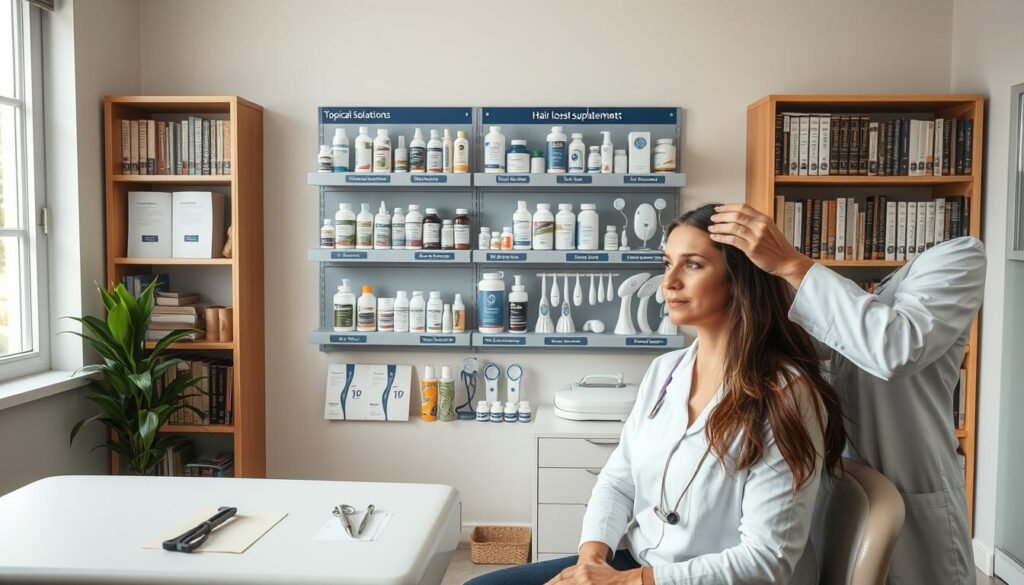
Minoxidil: The FDA-Approved Solution
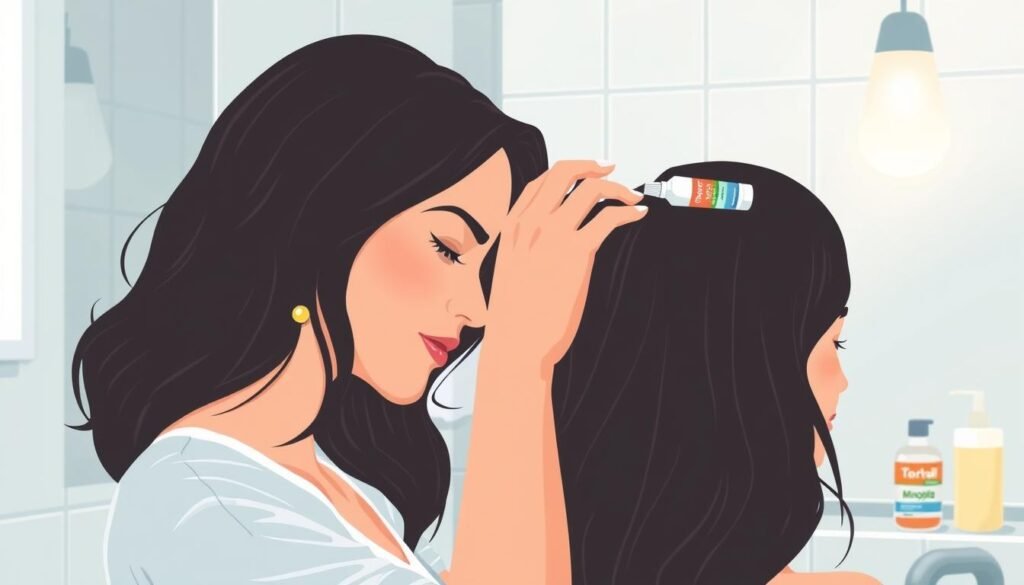
For women experiencing hair loss, Minoxidil stands out as a clinically proven solution. Minoxidil is the only FDA-approved topical treatment for female pattern hair loss, with decades of research supporting its efficacy.
How Minoxidil Works
Minoxidil works by widening blood vessels in the scalp, increasing blood flow and delivering more nutrients and oxygen to hair follicles. This process extends the growth phase of hair follicles and increases the size of miniaturized follicles, resulting in thicker, longer hair.
Application Tips and Best Practices
Proper application involves applying the Minoxidil solution directly to a dry scalp, focusing on areas of thinning, and allowing it to fully absorb before styling. Consistency is crucial—Minoxidil must be used daily, and results typically appear after 3-6 months of regular use.
Potential Side Effects
Common side effects may include scalp irritation, dryness, flaking, or unwanted hair growth on adjacent skin if the product drips. If treatment is discontinued, any new hair growth will likely be lost within 3-6 months as hair returns to its pre-treatment state.
Minoxidil is available in 2% and 5% concentrations, with the 2% formula typically recommended for female pattern hair loss. By understanding how to use Minoxidil effectively, women can achieve significant improvements in hair density and overall hair health.
Best Hair Loss Treatment for Female Pattern Baldness
For women experiencing hair loss, finding the right treatment can be a daunting task. Fortunately, several effective options are available to help address female pattern baldness.
Rogaine for Women
Rogaine for Women is a popular choice for treating hair loss, containing 5% minoxidil foam that is clinically proven to regrow hair in 81% of women with once-daily application. The foam formula is preferred by many women as it’s less likely to cause scalp irritation and doesn’t leave hair looking greasy compared to liquid solutions.
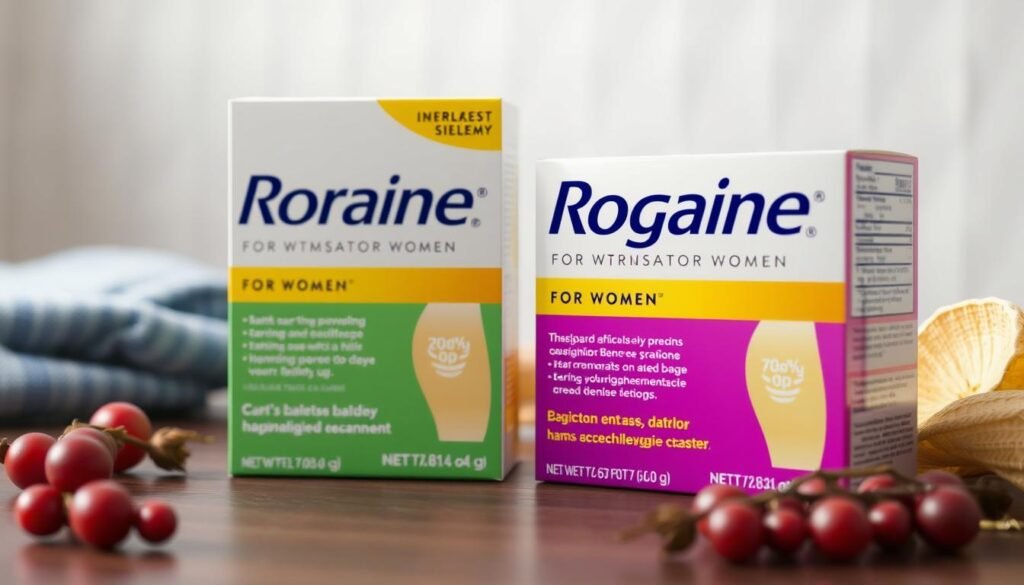
Keeps 5% Minoxidil Foam
Keeps 5% Minoxidil Foam offers the same active ingredient as Rogaine but is often more affordable through subscription services. Users report that Keeps foam absorbs quickly into the scalp without causing irritation, making it ideal for women with sensitive skin.
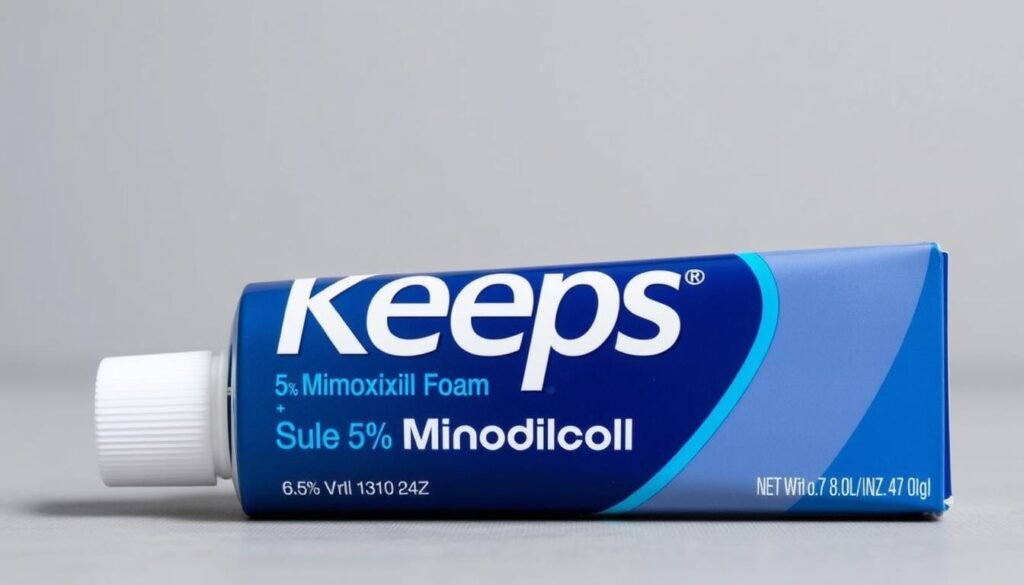
Hers 2% Minoxidil Solution
Hers 2% Minoxidil Solution features a convenient dropper applicator that allows for precise application directly to problem areas. Though lower in concentration, the 2% solution is specifically formulated for women and minimizes the risk of unwanted facial hair growth.
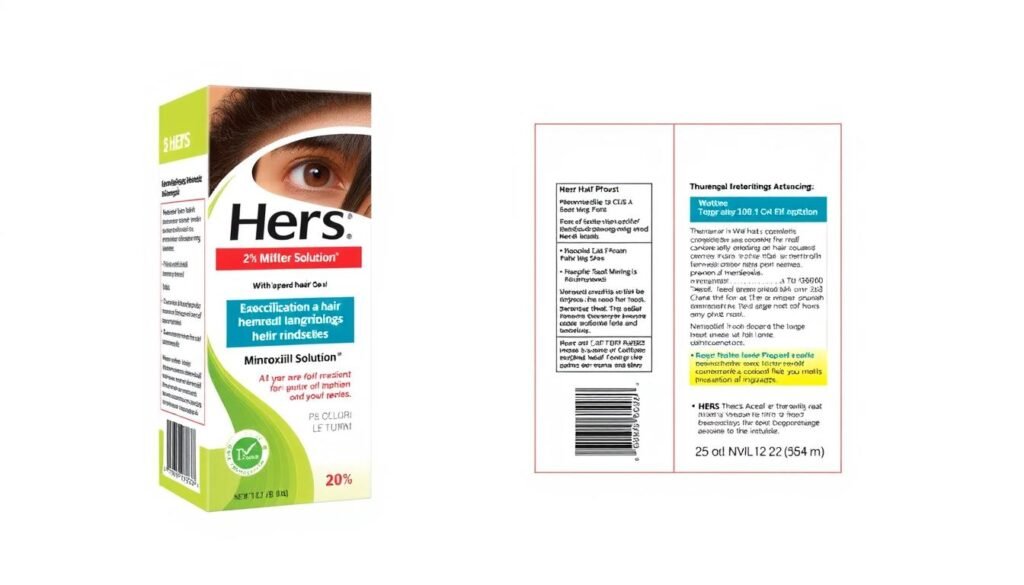
All three products require consistent use for at least 3-4 months before visible results appear, with optimal results typically seen after 12 months. These treatments work best when hair loss is caught early, as they’re more effective at maintaining existing hair and thickening miniaturized follicles than regrowing completely bald areas.
Topical Treatments Beyond Minoxidil
Beyond the popular minoxidil treatment, several other topical solutions have shown promise in addressing hair loss in women. These alternatives can be used alongside minoxidil for enhanced results or as gentler options for those who experience irritation.
Ketoconazole Shampoos
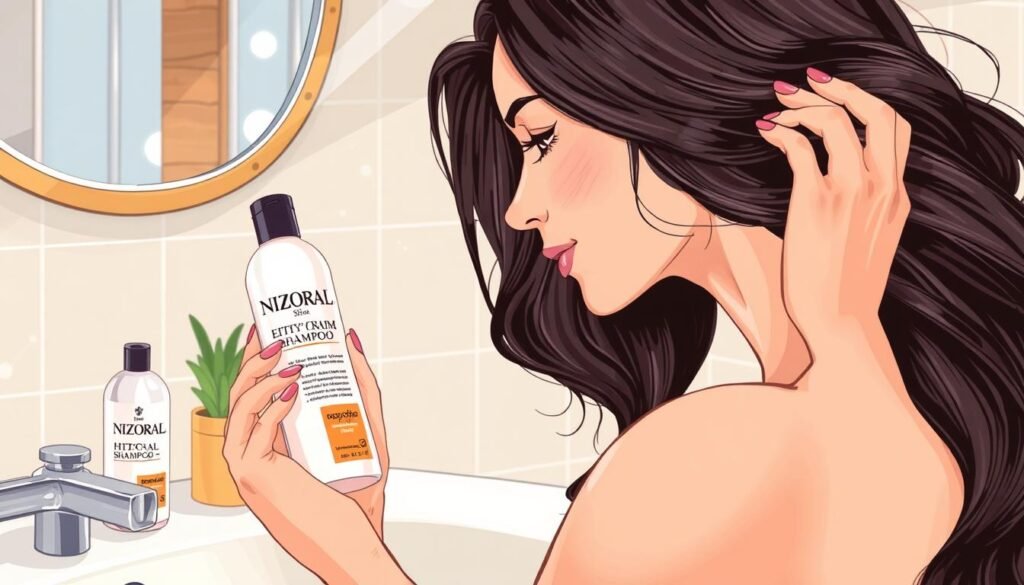
Ketoconazole shampoos, such as Nizoral, work by reducing scalp inflammation and fungal growth that can contribute to hair loss and dandruff. Studies show that ketoconazole may also have anti-androgenic properties that help block DHT, the hormone responsible for follicle miniaturization in pattern hair loss.
DHT-Blocking Serums
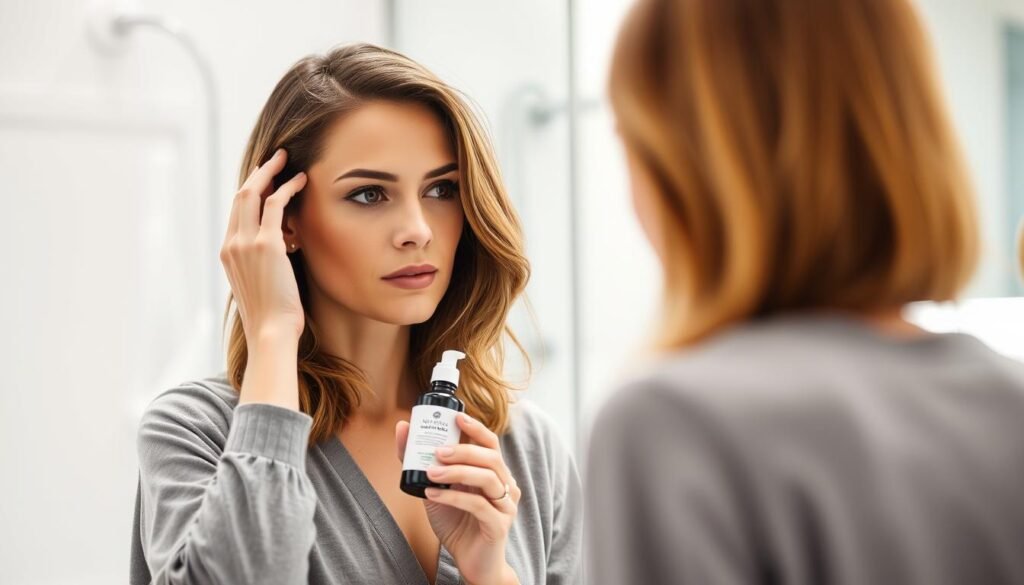
DHT-blocking serums containing ingredients like saw palmetto, pumpkin seed extract, and rosemary oil can help reduce the impact of androgens on hair follicles. Advanced Trichology NutraM DHT Blocking Hair Serum has shown impressive results in clinical testing, with users reporting decreased shedding and new growth.
Caffeine-Based Products
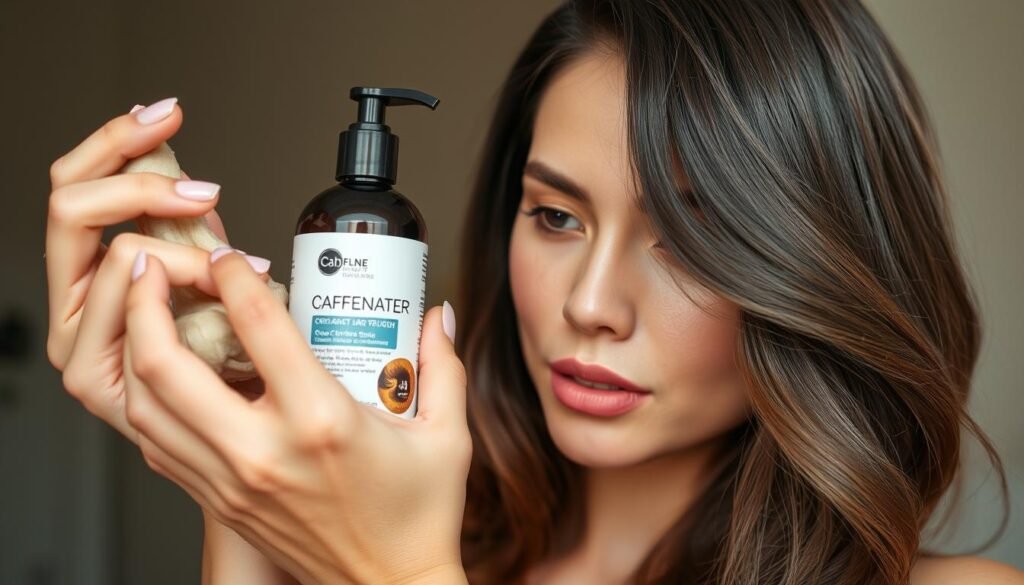
Caffeine-based hair products stimulate the hair follicles directly when applied topically, extending the growth phase of the hair cycle. Research indicates that caffeine compounds can penetrate the scalp and may counteract the effects of testosterone on hair follicles.
These alternative topical treatments require consistent, long-term use to maintain results, similar to minoxidil-based treatments. By incorporating these products into a hair care routine, women can potentially enhance their hair growth and reduce shedding.
Low-Level Light Therapy Options
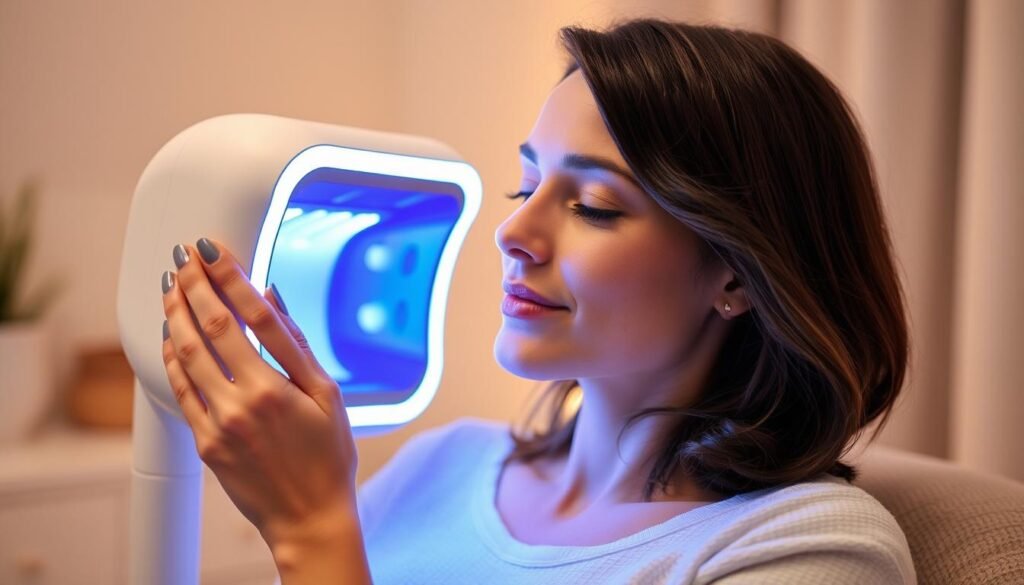
Female hair loss can be effectively managed with low-level light therapy, a non-invasive treatment option. Low-level light therapy (LLLT) uses red light wavelengths to stimulate cellular activity in hair follicles, potentially reversing miniaturization and extending the growth phase.
At-Home Laser Devices
At-home LLLT devices, such as laser combs, bands, and helmets, have shown promising results in clinical studies with minimal side effects reported. The HairMax LaserComb and iRestore Laser Hair Growth System are popular consumer options that have demonstrated efficacy in controlled trials. These devices typically require 8-15 minutes of use three times weekly, with initial results visible after 3-4 months of consistent treatment.
Professional Light Treatments
Professional LLLT treatments performed in dermatology offices or hair restoration clinics use more powerful devices than at-home options. Clinical treatments are typically scheduled 1-2 times weekly for 6-8 weeks, followed by maintenance sessions every 1-3 months. LLLT works particularly well as a complementary treatment when combined with minoxidil or other topical treatments, enhancing overall hair growth and treatment results.
The non-invasive nature and lack of significant side effects make LLLT an attractive option for women who cannot tolerate topical medications. While LLLT may not be a sufficient hair loss treatment on its own, it can amplify the effects of other treatments, leading to improved overall hair growth and satisfaction with treatment.
Medical Procedures for Hair Loss
Medical procedures provide an effective approach to treating female hair loss. For women experiencing significant hair loss, these treatments can offer a more permanent solution compared to topical treatments or medications.
Platelet-Rich Plasma (PRP) Injections
Platelet-Rich Plasma (PRP) therapy is a revolutionary treatment that harnesses the body’s natural growth factors to stimulate hair follicles and improve hair density. The procedure involves drawing the patient’s blood, processing it to concentrate the platelets, and injecting this platelet-rich solution into the scalp.
Most PRP protocols recommend 3-4 initial treatments spaced 4-6 weeks apart, followed by maintenance sessions every 4-6 months. Clinical studies have shown that PRP can increase hair count by 30-40% in responsive patients, with visible results after 3-6 months.
Hair Transplantation
For women with stable pattern hair loss and sufficient donor hair, hair transplantation is a viable option. This procedure involves taking small pieces of the scalp from donor areas and transplanting them to the balding areas to increase hair growth naturally.
Modern hair transplantation techniques, such as Follicular Unit Extraction (FUE), have significantly improved the outcomes, leaving minimal scarring and creating natural-looking results. Women with sufficient donor hair are ideal candidates, though the procedure may not be suitable for those with diffuse thinning.
Both PRP injections and hair transplantation can be combined with topical treatments for enhanced and maintained results over time. It’s essential to consult with a healthcare professional to determine the most suitable treatment plan based on individual needs and the extent of hair loss.
Hormone Therapy Approaches
Addressing the root cause of hair loss, hormone therapy has emerged as a viable option for women suffering from hormonal hair loss. Hormonal imbalances are a significant factor in female hair loss, particularly in conditions like polycystic ovary syndrome (PCOS) and during menopause.
Hormone therapy targets these imbalances to prevent further hair loss and, in some cases, promote hair regrowth. There are several approaches within hormone therapy that have shown promise.
Anti-Androgen Medications
Anti-androgen medications, such as spironolactone, are used to counteract the effects of androgens on hair follicles. Androgens can contribute to hair loss in women, especially those with PCOS. Spironolactone works by blocking the effects of these male hormones, thereby preventing further hair loss.
Typically prescribed off-label for female pattern hair loss, spironolactone is administered at doses of 50-200mg daily. Results are usually noticeable after 6-12 months. However, it’s crucial to monitor blood pressure and potassium levels during treatment, and it’s contraindicated during pregnancy.
Hormone Replacement Therapy
Hormone replacement therapy (HRT) is another approach that may benefit women experiencing hair loss related to menopause. By stabilizing estrogen levels, HRT can help counteract the negative effects of androgens on hair follicles, improving overall hair quality and thickness.
Oral contraceptives containing estrogen and an anti-androgenic progestin can also be effective for women with hormone-related hair loss. However, these treatments should be used under medical supervision due to their potential impact on multiple body systems.
| Treatment | Mechanism | Benefits | Precautions |
|---|---|---|---|
| Spironolactone | Blocks androgen effects | Reduces hair loss in women with PCOS | Monitor blood pressure and potassium; contraindicated in pregnancy |
| Hormone Replacement Therapy (HRT) | Stabilizes estrogen levels | Improves hair quality and thickness during menopause | Requires medical supervision; potential systemic effects |
| Oral Contraceptives | Regulates hormonal balance | Effective for hormone-related hair loss | Should be used under medical guidance |
For more information on hair and scalp conditions, including the latest treatments and expert advice, visit Trisha Khanna’s Dermatology Page.

Natural Remedies and Supplements
The quest for healthy hair growth has led many to explore natural remedies and supplements. While conventional treatments are available, some individuals prefer a more holistic approach to addressing hair loss.
Several natural remedies have shown promise in promoting hair growth and reducing hair loss. One such remedy is essential oils.
Essential Oils for Hair Growth

Essential oils, such as rosemary oil, have been studied for their potential in promoting hair growth. A 2015 study found rosemary oil to be as effective as 2% minoxidil in stimulating hair growth after six months. To use rosemary oil effectively, mix a few drops with a carrier oil and massage it into your scalp.
Peppermint oil is another essential oil that may stimulate hair growth by increasing blood circulation to the scalp. However, it’s crucial to dilute essential oils with a carrier oil to prevent scalp irritation.
Vitamins and Minerals
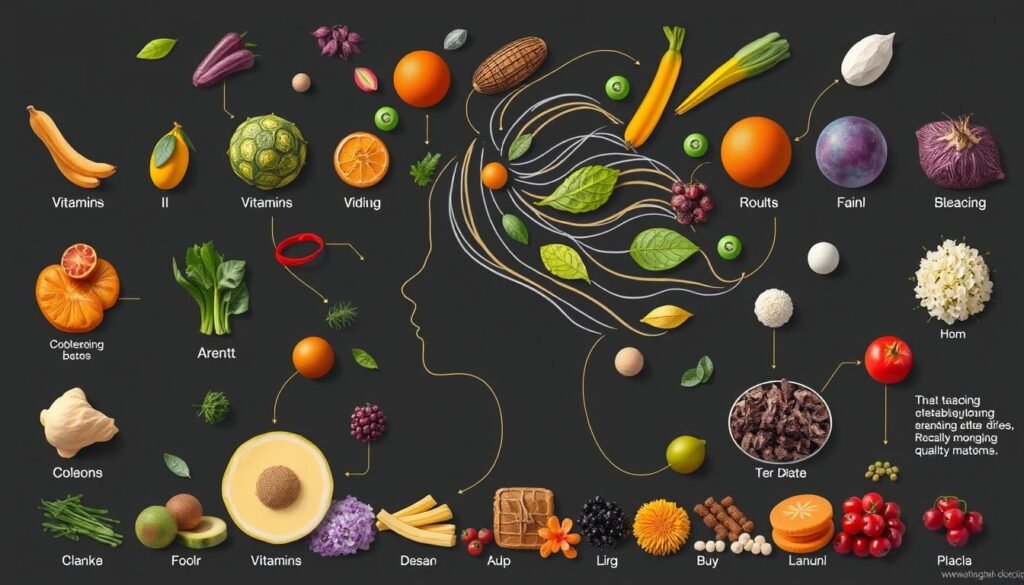
Certain vitamins and minerals play a significant role in maintaining healthy hair. Iron deficiency, for instance, is strongly linked to hair loss in women. Ensuring adequate iron intake through diet or supplements is crucial.
Biotin (Vitamin B7) supports keratin production and is widely used for hair health, although its effectiveness in non-deficient individuals is not extensively scientifically proven. Vitamin D deficiency has also been associated with alopecia, making supplementation potentially beneficial for those with low levels.
Herbal Supplements

Herbal supplements like saw palmetto are gaining attention for their potential in addressing hair loss. Saw palmetto acts as a natural DHT blocker, similar to some prescription medications. Additionally, adaptogens such as ashwagandha and ginseng may help reduce stress-related hair loss by normalizing cortisol levels.
Scalp Care for Healthy Hair Growth
Healthy hair growth starts with a healthy scalp environment. A well-maintained scalp is essential for optimal hair growth, as it ensures that hair follicles receive the necessary nutrients and are free from buildup that can impede growth.
Massage Techniques
Massaging the scalp can increase blood circulation, promoting hair growth. Daily scalp massage for 4-5 minutes can stimulate blood flow, bringing more nutrients to hair follicles. To massage effectively, use your fingertips to apply gentle pressure in circular motions across the scalp.
Exfoliation and Cleansing
Regular exfoliation removes dead skin cells and product buildup, maintaining a clean follicular environment. Gentle scalp exfoliants containing salicylic acid or fruit enzymes can be used weekly. Additionally, clarifying shampoos can help remove silicone and product buildup, but should be used sparingly to avoid stripping natural oils.
| Scalp Care Practice | Benefits | Frequency |
|---|---|---|
| Scalp Massage | Increases blood circulation, promotes hair growth | Daily (4-5 minutes) |
| Exfoliation | Removes dead skin cells, product buildup | Weekly |
| Clarifying Shampoo | Removes silicone, product buildup | Every 1-2 weeks |
Diet and Nutrition for Hair Health
Eating a nutritious diet is essential for supporting hair health and promoting normal hair growth. A diet rich in essential nutrients helps maintain the integrity of hair follicles, supporting the growth cycle and reducing the risk of hair loss.
Iron-Rich Foods
Iron deficiency is a common cause of hair loss, particularly in women of reproductive age. Consuming iron-rich foods like lean red meat, spinach, lentils, and fortified cereals can help. It’s beneficial to eat these foods with vitamin C-rich foods to enhance iron absorption.
Protein and Biotin Sources
Hair is primarily made of protein, making adequate protein intake crucial. Foods rich in protein include eggs, fish, poultry, dairy, and plant-based combinations. Biotin-rich foods such as eggs, nuts, seeds, and sweet potatoes support keratin production, which is vital for hair structure.
Anti-Inflammatory Diet Choices
Chronic inflammation can contribute to hair loss. An anti-inflammatory diet that includes omega-3 fatty acids found in fatty fish, walnuts, and flaxseeds, along with colorful fruits and vegetables, can be beneficial. Minimizing processed foods and refined sugars is also recommended.
Hair Care Practices to Prevent Further Loss
Gentle hair care is vital for minimizing hair loss and maintaining the health of your hair. Proper care can significantly reduce the risk of further loss and protect your existing hair.
Gentle Styling Tips
Using wide-toothed combs and soft-bristled brushes can help minimize breakage. It’s also advisable to detangle wet hair gently from the ends to the roots. Avoiding hairstyles that pull tightly on the hairline, such as tight ponytails or braids, can prevent traction alopecia.
Products to Avoid
Certain hair care products can exacerbate hair thinning. Products containing harsh sulfates, alcohols, and silicones can strip the hair and scalp of natural oils. It’s also best to avoid products with parabens, synthetic fragrances, and formaldehyde-releasing preservatives, as they may cause scalp irritation.
Heat and Chemical Treatment Advice
Limiting heat styling to once or twice a week and using a heat protectant can help reduce damage. Keeping heat tools below 350°F is also recommended. For chemical treatments like coloring or perming, spacing them out and opting for gentler, ammonia-free formulations can minimize harm.
| Hair Care Practice | Benefit |
|---|---|
| Gentle Styling | Reduces breakage and hair loss |
| Avoiding Harsh Products | Prevents scalp irritation and hair thinning |
| Limited Heat Styling | Minimizes damage and promotes hair health |
Complete Hair Loss Treatment Systems
Women can now benefit from comprehensive hair loss treatment systems that tackle thinning from multiple angles. These systems are designed to address various aspects of hair loss, providing a more effective solution than individual products.
Complete hair loss treatment systems typically include a combination of products such as shampoos, conditioners, and leave-in treatments that work together to strengthen hair and promote scalp health.
Nioxin System Kits
Nioxin System Kits are customized based on hair type and the degree of thinning, offering a tailored approach to addressing hair loss. The kits include a therapeutic shampoo, conditioner, and scalp treatment, formulated with ingredients like peppermint oil, niacinamide, and biotin.
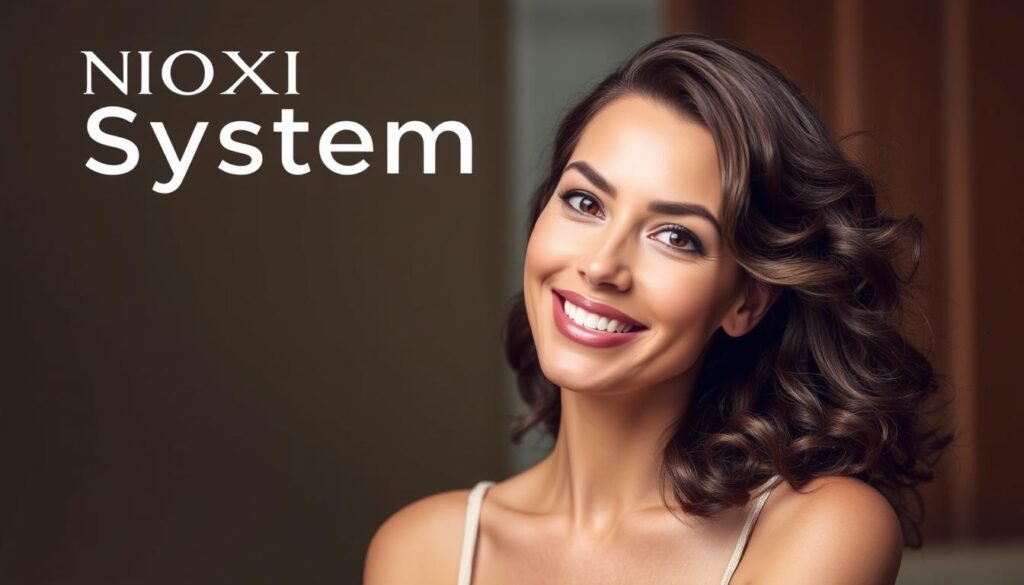
Vegamour GRO System
The Vegamour GRO System features plant-based ingredients that inhibit DHT production, promoting healthier hair growth. This comprehensive system includes a shampoo, conditioner, serum, and dietary supplements that work synergistically to address hair loss.
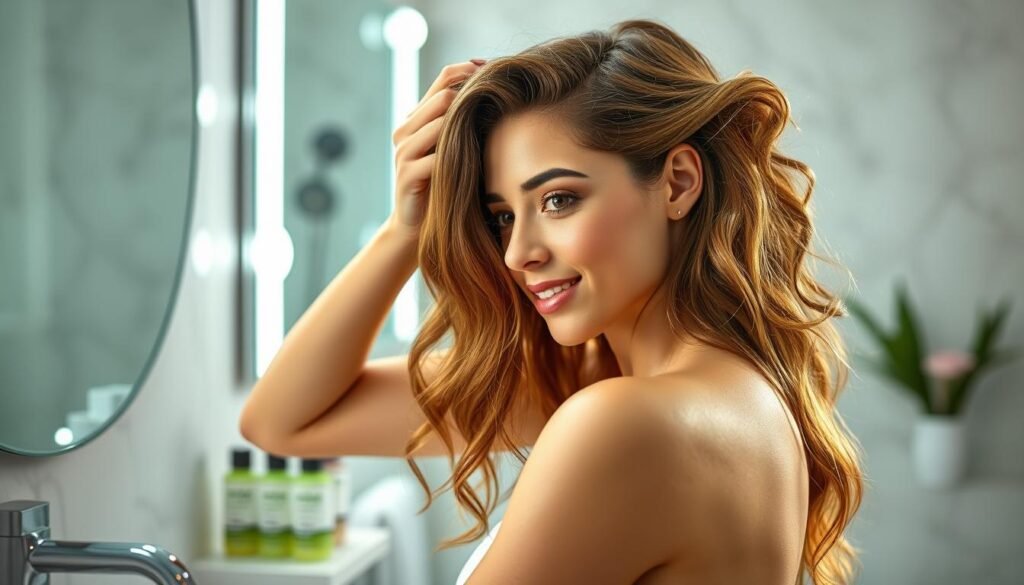
BosleyMD Revive Volumizing System
BosleyMD Revive Volumizing System combines DHT-blocking botanicals with nourishing ingredients to create immediate volume while addressing long-term thinning. The system includes a thickening shampoo, volumizing conditioner, and leave-in treatment.
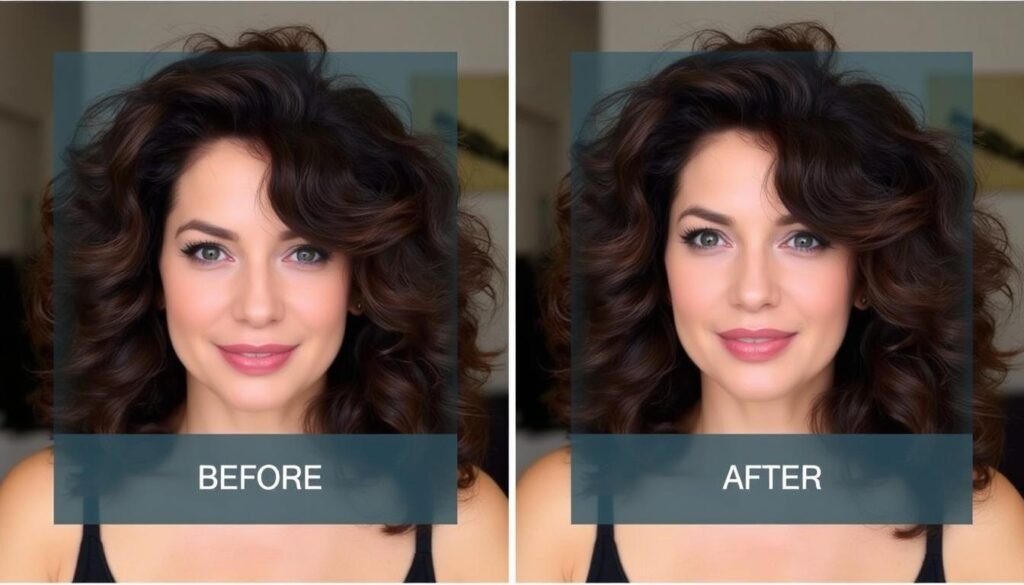
Coping with Hair Loss Emotionally
The emotional impact of hair loss on women is profound, often leading to issues with self-esteem and body image. Research indicates that women experiencing hair loss report higher levels of anxiety, depression, and social withdrawal.
Acknowledging these emotional impacts is crucial for developing healthy coping strategies. Support groups, both online and in-person, can offer valuable emotional support. Consulting with a mental health professional can also help in addressing associated anxiety or depression.
Temporary cosmetic solutions such as wigs, hair toppers, and scalp micropigmentation can enhance confidence during treatment. Experimenting with hairstyles that maximize volume, like layered cuts, can also help disguise thinning areas.
| Coping Strategy | Description | Benefit |
|---|---|---|
| Support Groups | Online and in-person groups for emotional support | Reduces feelings of isolation |
| Mental Health Consultation | Professional help for anxiety and depression | Develops effective coping mechanisms |
| Cosmetic Solutions | Wigs, hair toppers, scalp micropigmentation | Enhances confidence |
| Hairstyle Adjustments | Layered cuts and volumizing styles | Disguises thinning areas |
Practicing self-compassion and focusing on aspects beyond physical appearance is vital for emotional wellbeing. By adopting these strategies, women can better cope with the emotional challenges of hair loss over time.
Conclusion
Effective management of hair loss in women often necessitates a multi-faceted strategy that includes medical treatments, nutritional adjustments, and gentle hair care practices. Understanding the specific cause of hair loss is crucial in selecting the most appropriate interventions.
Minoxidil remains a cornerstone among FDA-approved topical treatments, with proven efficacy for many women experiencing pattern hair loss. A comprehensive approach that combines topical treatments like minoxidil with proper scalp care, nutrition, and addressing any underlying health conditions often yields the best results.
Patience is essential when treating hair loss—most treatments require at least 3-6 months of consistent use before noticeable improvements appear. It’s also important to be cautious of products making unsubstantiated claims, as the hair loss industry is filled with ineffective “miracle cures.” Consulting with a dermatologist or trichologist is highly recommended for personalized treatment recommendations.
With the right approach and realistic expectations, many women can successfully manage hair loss and maintain healthier, fuller-looking hair over time. New options are continuously being researched, offering hope for even more effective treatments in the future.

